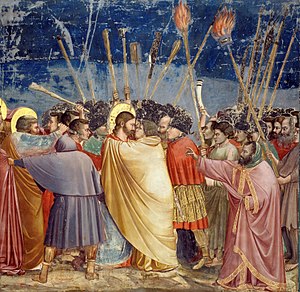The fresco cycle in the Arena Chapel painted by Renaissance
artist Giotto is world famous. Enrico Scrovengi was the patron of the Arena
Chapel. Because his father was a banker who made a lot of money and “he took
over his father's lucrative business and had amassed a fortune by lending money
at high rates, a practice that the church and fellow citizens saw as sinful”,
“Enrico had built the chapel thinking it would guarantee him a place in heaven”
and wash away his sins,. Since “Enrico Scrovengi was one of Padua's best known
and wealthiest citizens” , it is likely that he also wanted to build the chapel
to show his wealthiness to public. Another possible reason he built the chapel
may have been for convenience.
In order to link all the fresco scenes in the chapel
together, Giotto “designed frames that form a continuous structure of simulated
architecture” . Every fresco scene is inside the different ‘rooms,’ created by
the frames. The frames are detailed, decorated with mosaic like patterns and
every clover shape in the frames also contains a tiny religious scene. The whole fresco cycle “illustrate the lives
of Virgin and Christ”2.
Kiss of Judas is one of the scenes from the fresco cycle and
it is the one that most catches my eyes. As you go inside the church, this
scene is the middle one located in the second level row of the right hand wall.
The subject matter is from Bible: Judas, one of the twelve disciplines of
Jesus, betrayed Jesus with a kiss to show his identity to soldiers.
In spite of the dark theme of betrayal, Giotto used a large
range of color to paint this fresco the same as other pieces in Arena Chapel,
which helps harmonize of all frescos. He used dark blue to paint the night sky,
which is the same color he used in the sky of other scenes and the ceiling
vault. But in this specific scene, dark blue gave the whole painting a heavy
and serious feeling. On the other hand, Giotto didn’t use deep color on the
people but gave them colorful dressing, which lets the viewer distinguish
different characters easily in such a chaotic situation. For example, Judas’s
robe was painted with bright yellow, which becomes an eye-catching point of the
whole painting and instantly leads the viewer to the most important center of
the whole painting. The outlines of the characters aren’t thick, but very
clear. Again, the clear line emphasizes the details of the painting and viewer
can easily distinguish different figures and objects.
In order to show the feeling of many people and the scale of
the chaos, Giotto layered the people behind the main character one by one. Some
of them can be seen just by their head. This layering technique gives the
painting a strong feeling of space. Giotto also used the chiaroscuro technique
to illustrate the three-dimensional world. The light and shadow he used bring
the naturalistic feeling, which is very different from the two-dimensional
world in the medieval arts. Viewers can easily see the realistic folds of
clothes achieved through the chiaroscuro technique.
Instead of making the Jesus’s scale exaggerate to show this
religious story as in the medieval arts, all the characters in the painting are
in the same scale, so that the whole painting is just like a historical event;
Christ is like a human who is no different than the others. Therefore Christ’s
humanity is emphasized over his divinity. This makes the painting more
believable to the viewer.
Every corner of the painting is filled with a kind of
eye-catching event. The long weapons stretch out of the dark sky, making a
strong contrast and a feeling of chaos. The weapons also form a kind of
invisible line that pointing against Jesus and Judas, and almost all
characters’ eyes are focusing at them, which emphasize the main point of the
whole painting. One soldier is blowing his horn, it convey the viewer a
simulated acoustic signal besides graph experience. St. Peter is cutting
another soldier’s ear, which shows the contrast between St. Peter’s loyalty and
Judas’s betrayal. Giotto indicated this kind of connection by painted both of
them in yellow. Judas embraces Jesus with a treacherous kissing, but Jesus look
at him calmly. This shows the forgiveness to sins and evil which meets the
purpose that the patron built the Arena Chapel.
This scene Kiss of Judas links with the whole fresco painting
by the architecture frame Giotto painted, and also by the same blue sky in all
scenes. It emphasizes the theme of forgiveness which is also within the whole
fresco cycle. It is one of the important scenes chose by Giotto from the life
of Jesus to show forgiveness of Jesus and the evil of betrayal.
The chapel is used to influence the people of Christianity,
so this fresco is also used to convey religious message. The color of this
painting is eye catching and the lines are detailed, so that the viewer can be
easily attracted. The scene is full of humanism instead of rigid medieval
style, so that it can be better to convey religious message. The painting shows
grief and indignation of Jesus being betrayed, which can easily arouse viewers
sympathy. As mentioned before, forgiveness is the most important religious
message the Giotto wanted to convey. Because it met his patron’s demand to wash
away his sins.

No comments:
Post a Comment